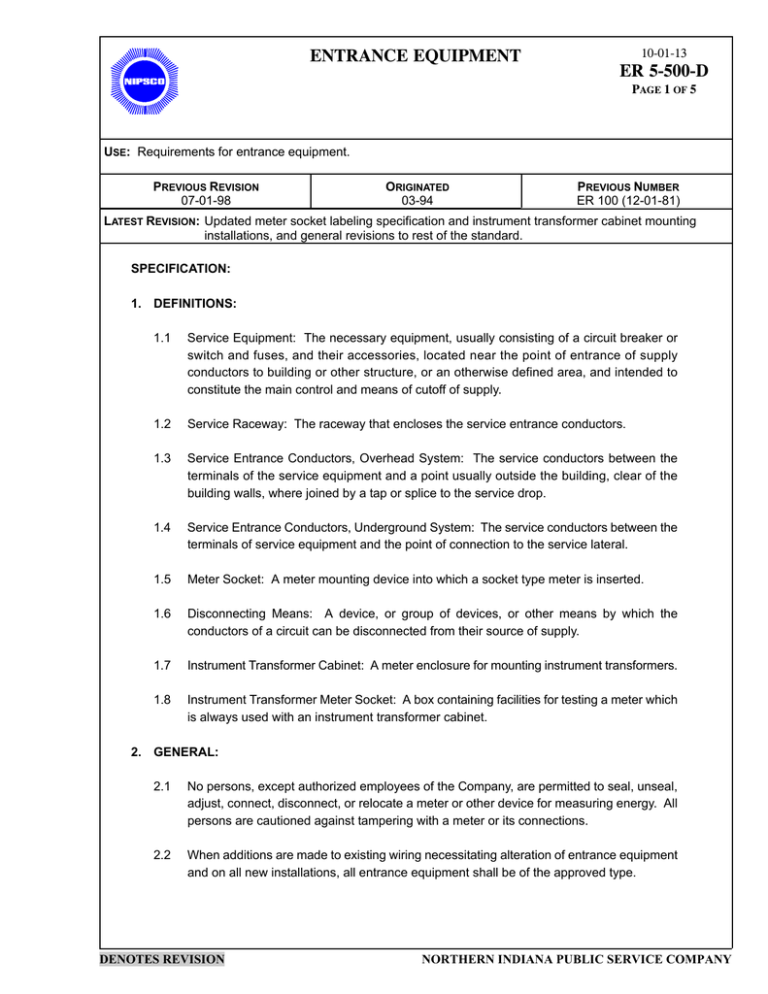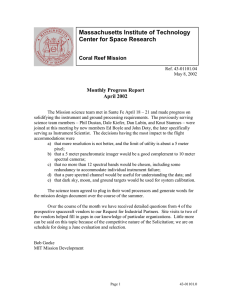entrance equipment
advertisement

ENTRANCE EQUIPMENT 10-01-13 ER 5-500-D PAGE 1 OF 5 USE: Requirements for entrance equipment. PREVIOUS REVISION 07-01-98 ORIGINATED 03-94 PREVIOUS NUMBER ER 100 (12-01-81) LATEST REVISION: Updated meter socket labeling specification and instrument transformer cabinet mounting installations, and general revisions to rest of the standard. SPECIFICATION: 1. DEFINITIONS: 1.1 Service Equipment: The necessary equipment, usually consisting of a circuit breaker or switch and fuses, and their accessories, located near the point of entrance of supply conductors to building or other structure, or an otherwise defined area, and intended to constitute the main control and means of cutoff of supply. 1.2 Service Raceway: The raceway that encloses the service entrance conductors. 1.3 Service Entrance Conductors, Overhead System: The service conductors between the terminals of the service equipment and a point usually outside the building, clear of the building walls, where joined by a tap or splice to the service drop. 1.4 Service Entrance Conductors, Underground System: The service conductors between the terminals of service equipment and the point of connection to the service lateral. 1.5 Meter Socket: A meter mounting device into which a socket type meter is inserted. 1.6 Disconnecting Means: A device, or group of devices, or other means by which the conductors of a circuit can be disconnected from their source of supply. 1.7 Instrument Transformer Cabinet: A meter enclosure for mounting instrument transformers. 1.8 Instrument Transformer Meter Socket: A box containing facilities for testing a meter which is always used with an instrument transformer cabinet. 2. GENERAL: 2.1 No persons, except authorized employees of the Company, are permitted to seal, unseal, adjust, connect, disconnect, or relocate a meter or other device for measuring energy. All persons are cautioned against tampering with a meter or its connections. 2.2 When additions are made to existing wiring necessitating alteration of entrance equipment and on all new installations, all entrance equipment shall be of the approved type. DENOTES REVISION NORTHERN INDIANA PUBLIC SERVICE COMPANY 10-01-13 ER 5-500-D ENTRANCE EQUIPMENT PAGE 2 OF 5 2.3 The Customer shall furnish a meter socket, unless it is a transformer rated meter socket (transformer rated meter sockets are furnished by the Company). The meter socket shall be installed by the Customer at his expense. The Customer may use a completely sealable single or multiple meter socket circuit breaker assembly approved and listed on Company Standards and said assembly shall be furnished and installed by the Customer at his expense. 2.4 A three foot space shall be provided in front of all instrument transformer cabinets, transformer rated meter sockets, and meter sockets so that all metering equipment may be inspected and tested. 2.5 All installations of more than one meter shall be arranged for a three wire service. 2.6 The load on all three wire services shall be as nearly balanced as is practical. 2.7 Contractors or wiremen shall leave their name and address on all installations to facilitate approval and, if possible, leave the name and address of the Owner. 2.8 For installations involving multiple, grouped meters, the contractor shall label each meter socket (including the inside of the socket), and it's respective main disconnect, in a distinctive, permanent, and legible manner, identifying the location they are to serve (Apt #, Unit #, etc.). The labels must be either engraved nameplates or adhesive-type labels at least one inch high. Felt tip pens and label maker tape are not considered permanent marking. The location itself, shall also be labeled with it's respective identification marking. Meters shall not be installed and energized until this identification has been completed. The Company will assume no responsibility for the accuracy of matching premise location as indicated on the meter socket and main disconnect switch. 2.9 All single phase installations of a load of 320 amperes and under, where the voltage between conductors does not exceed 300 volts, shall be wired for self-contained meters. Where future load growth in excess of 320 amperes for single phase installations is anticipated, an instrument transformer installation may be made for initial loads of less than 320 amperes. 2.10 All three phase installations of a load of 200 ampere and under, where the voltage between conductors does not exceed 300 volts, shall be wired for self-contained meters. Where future growth in excess of 200 amperes for three phase installations is anticipated, an instrument transformer installation may be made for initial loads of less than 200 amperes. 2.11 Installation of more than 320 amperes for single phase and 200 amperes for three phase, or where the voltage between conductors is more than 300 volts, shall be made for instrument transformers. 2.12 Bonding jumpers shall be used around concentric or eccentric knockouts in service equipment per NEC latest revision. DENOTES REVISION NORTHERN INDIANA PUBLIC SERVICE COMPANY ENTRANCE EQUIPMENT 10-01-13 ER 5-500-D PAGE 3 OF 5 3. ARRANGEMENT OF EQUIPMENT: 3.1 All self-contained service installations of 320 amperes capacity or less for single phase, or 200 amperes capacity or less for three phase, where the voltage between conductors does not exceed 300 volts, shall have a sequence of meter, switch, fuse. 3.2 Instrument transformer service installations may have either a sequence of meter, switch, fuse (instrument transformers with meter, switch protective equipment) or a sequence of switch, fuse, meter (switch, protective equipment, instrument transformers with meter). 4. SWITCHES AND PROTECTIVE EQUIPMENT: 4.1 If there are not more than a total of six closely grouped switches (manually operable, with overcurrent protection) at the service entrance, including the emergency power switch, they may be considered the disconnecting means and no master entrance switch will be required. 4.2 On any service run supplying energy through more than six meters, one master entrance switch shall be installed which will interrupt all circuits supplied by that run, excluding emergency circuits. Each meter shall have a meter socket and switch. 4.3 In all cases, fuses shall be omitted from the neutral or ground wire. 4.4 Entrance switches arranged for a sequence of switch, fuse, meter shall be of a type to permit sealing of the switch box. 4.5 If the entrance equipment is arranged for a sequence of meter, switch, fuse, the Company issued no specifications as to the type of protective equipment and wiring used beyond the instrument transformers and meter or meter socket except that all equipment shall conform to the Standard Of Work. 4.6 The disconnecting means, fuse cabinet, or circuit breaker should be placed inside the building as near as possible to the meter socket or instrument transformer cabinet. If it is necessary to locate the switch outdoors, the weatherproof installation shall be made. Indoor equipment may be used outdoors if protected by weatherproof enclosures. 4.7 The switch or fuse cabinet should be as near as possible to a meter socket that is located indoors. 4.8 When standby service is supplied, a double throw switch or similar device shall be used. The arrangement of the wiring shall be such that it is impossible to operate the two systems together. Arrangement of the wiring and type of switch or similar device shall be approved by the Company. DENOTES REVISION NORTHERN INDIANA PUBLIC SERVICE COMPANY 10-01-13 ER 5-500-D ENTRANCE EQUIPMENT PAGE 4 OF 5 5. INSTRUMENT TRANSFORMER INSTALLATIONS: 5.1 In Pad Mount Transformer Secondary Compartments: 5.1.1 A pad mount transformer metering installation should be used when service to one (1) Customer is supplied from one (1) pad mount transformer requiring only one (1) metering point. The Company will furnish and install all metering equipment as shown in ER 13-210. 5.1.2 In some dual rate applications, where two (2) sets of current transformers are required, this type metering installation may be used. The dual rate application must be approved on an individual basis in advance through the Local Operating Area Engineering Department and the Electric Metering Department. 5.1.3 For installations exceeding 300 volts between conductors, the secondary service conductors from the pad mount transformer shall be wired in a manner to provide adequate space for mounting three (3) instrument potential transformers. 5.1.4 A potential tap on each phase and neutral shall be made with a compression connector furnished and installed by the Company. The compression connector shall be attached under the lug mounting bolt used by the customer for the secondary service conductor connections. 5.2 In Cabinets Or Compartments Other Than Pad Mount Transformers: 5.2.1 The Customer shall furnish and install an approved instrument transformer cabinet. The Company will furnish, and the Customer shall install, a transformer rated meter socket. 5.2.2 The Customer shall furnish and install a 1-1/2" rigid metal conduit from the instrument transformer cabinet to the transformer rated meter socket. The Company will furnish the instrument transformers and make all connections from the instrument transformer secondaries to the transformer rated meter socket. 5.2.3 All instrument transformer cabinets shall be mounted in an approved manner and as shown in ER 19-255 (for overhead installations), or ER 19-280 (for underground installations). 5.2.4 The instrument transformer cabinet will be sealed by the Company and therefore shall not be used as a distribution cabinet. 5.2.5 For all installations using instrument transformers not exceeding 300 volts between conductors, where the sequence used is meter, switch, fuse, the Customer shall provide an instrument transformer cabinet of a type approved by the Company. This cabinet shall have provision for bypassing, removing, and replacing current transformers while energized. DENOTES REVISION NORTHERN INDIANA PUBLIC SERVICE COMPANY ENTRANCE EQUIPMENT 10-01-13 ER 5-500-D PAGE 5 OF 5 5.2.6 For all installations using instrument transformers, where the sequence used is switch, fuse, meter, the Customer shall provide an approved instrument transformer cabinet. For this type of installation, the instrument transformer cabinet may be deenergized for removing or replacing instrument transformers. 5.2.7 An approved instrument transformer cabinet may be installed with an approved unfused enclosed sealable safety switch on the source side of the instrument transformer cabinet, if overcurrent protection is provided by not more than six circuit breakers or six fused switches closely grouped adjacent to the load side of the instrument transformer cabinet. 5.2.8 For installations in which the voltage exceeds 300 volts between conductors, the Customer shall provide an approved instrument transformer cabinet for mounting current and potential transformers. On these installations, the instrument transformers and their connections will not be worked while energized. If removal and replacement of an instrument transformer is required, the service shall be disconnected by use of a Customer owned switch on the source side of the cabinet, if available, or by opening the disconnects on the primary side of the Company's transformer bank. DENOTES REVISION NORTHERN INDIANA PUBLIC SERVICE COMPANY


